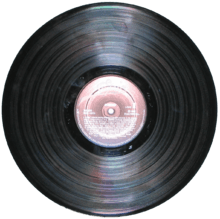LP record facts for kids

A typical LP, showing its center label
|
|
| Media type | Audio playback |
|---|---|
| Encoding | Analog grooves |
| Capacity | Typical 22-26 minutes per side; 2 sides |
| Read mechanism | Stylus |
| Dimensions | 12 in (30 cm); 10 in (25 cm) |
| Weight | 90-200 grams |
| Usage | Audio storage |
| Extended from | 1948 |
An LP record is a special type of gramophone record. It's also called a long-play record. Imagine a flat, round disc made of vinyl. This disc has tiny, swirling lines called grooves. These grooves hold the sound.
LPs usually come in two sizes: 10 or 12 inches wide. To play an LP, you need a turntable. The turntable spins the record at a speed of 33⅓ times per minute (rpm). A special arm on the turntable has a small needle at its end. This needle fits perfectly into the record's grooves. As the needle moves along the grooves, it picks up the sound, and you hear music!
Contents
The History of LP Records
When LPs First Appeared
Columbia Records first introduced the LP record in 1948. It quickly became a popular new way to release music recordings. Before LPs, records could only hold a few minutes of music. LPs could play much longer, which was a big deal for albums.
New Ways to Listen to Music
In the 1960s, cassettes came out. These were smaller and cheaper than LPs. Cassettes also had less noise than LP records sometimes did. Even with cassettes around, LPs stayed very popular.
However, in the 1970s, the compact disc (CD) was invented. CDs offered even clearer sound and were very easy to use. This new digital technology slowly made LPs less common for everyday listening.
Analog vs. Digital Sound
LP records store sound in an analog way. This means the sound waves are stored as physical shapes in the grooves. Think of it like a wavy line that matches the sound.
Later, new technology made digital sound possible. Digital sound turns music into numbers and codes. This change happened thanks to advances in computers in the 1970s and 1980s. While LPs have a unique sound, digital formats often have less distortion.
Images for kids
See also
 In Spanish: LP para niños
In Spanish: LP para niños



